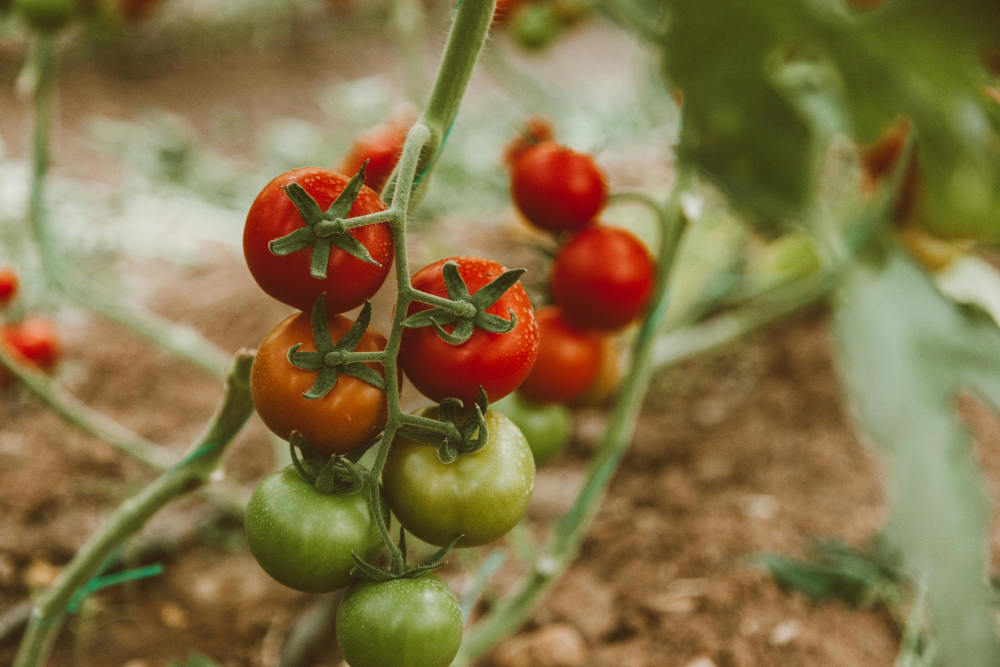
Les tomates comptent parmi les cultures les plus populaires en jardin potager, et pour cause. Leur saveur riche, leur polyvalence culinaire et leur rendement gratifiant en font un incontournable pour de nombreux jardiniers. Cependant, si vous vivez dans la zone de rusticité USDA 5b , où les hivers sont froids et les saisons de croissance courtes, semer des tomates en intérieur est essentiel pour une récolte réussie.
Ce guide vous explique exactement quand et comment démarrer les graines de tomates à l'intérieur dans la zone 5b , y compris le choix des bonnes variétés, la mise en place du succès du démarrage des graines et la garantie de greffes solides et saines prêtes pour le jardin.
Panaprium est indépendant et pris en charge par les lecteurs. Si vous achetez quelque chose via notre lien, nous pouvons gagner une commission. Si vous le pouvez, veuillez nous soutenir sur une base mensuelle. La mise en place prend moins d'une minute et vous aurez un impact important chaque mois. Merci!
Comprendre la zone 5b et son impact sur les tomates
La zone 5b se caractérise par des températures hivernales minimales moyennes de -26 °C à -23 °C (-15 °F à -10 °F) . Elle comprend certaines parties du nord des États-Unis, notamment le nord de l'État de New York, le nord de l'Illinois, une partie du Michigan et certaines régions montagneuses.
En raison de leur courte saison de croissance , les tomates, qui ont besoin de températures chaudes et d'une longue période sans gel , doivent être plantées à l'intérieur. Attendre avant de semer les graines en extérieur retarderait trop la croissance et la maturation avant les gelées d'automne.
Date du dernier gel dans la zone 5b
En zone 5b, la date moyenne du dernier gel se situe généralement entre le 1er et le 15 mai , selon les microclimats locaux et l'altitude. Pour la planification, de nombreux jardiniers utilisent généralement le 10 mai comme date de référence.
Quand commencer à semer des tomates à l'intérieur en zone 5b
Les graines de tomates doivent être démarrées à l'intérieur 6 à 8 semaines avant la dernière date de gel prévue .
-
Si votre dernière gelée date du 10 mai :
-
8 semaines avant = 15 mars
-
6 semaines avant = 29 mars
-
👉 Fenêtre idéale de démarrage des semis pour les tomates de la zone 5b : de la mi-mars à la fin mars
Ce calendrier donne à vos plants de tomates suffisamment de temps pour développer des systèmes racinaires solides et des tiges robustes sans devenir trop longs ou trop étroits au moment de la transplantation.
Pourquoi démarrer des tomates à l’intérieur dans la zone 5b ?
Les tomates sont des cultures de saison chaude qui :
-
Nécessite une température du sol d'au moins 15 °C (60 °F) pour prospérer
-
Sont tués par le gel
-
Il faut compter entre 50 et 100 jours pour arriver à maturité , selon la variété.
Commencer à l'intérieur :
-
Vous donne une longueur d'avance sur la saison de croissance
-
Vous aide à choisir parmi une plus large gamme de variétés de tomates
-
Résultats des récoltes plus précoces
-
Permet des transplantations plus saines et plus résistantes
Choisir des variétés de tomates pour la zone 5b
En raison de la courte saison de croissance, les jardiniers de la zone 5b bénéficient le plus des variétés à maturation précoce ou tolérantes au froid .
Variétés précoces et de mi-saison recommandées (55–75 jours) :
-
Early Girl – 57 jours
-
Célébrité – 70 jours
-
Stupice – 60 jours
-
Sungold (cerise) – 57 jours
-
Glacier – 55 jours
-
Bush Early Boy – 54 jours
Variétés anciennes recommandées :
-
Brandywine – 78–85 jours (nécessite un démarrage précoce en intérieur)
-
Cherokee Purple – 75–80 jours
-
Crimée noire – 75 jours
📝 Conseil : Pour la zone 5b, évitez les variétés de fin de saison (plus de 85 jours), à moins que vous ne soyez prêt à utiliser des serres, des couvertures de rangées ou des conteneurs qui peuvent être déplacés à l'intérieur tard dans la saison.
Étape par étape : Comment faire germer des graines de tomates à l'intérieur
1. Rassemblez les fournitures
Vous aurez besoin de :
-
graines de tomates
-
Plateaux à semis ou petits contenants avec trous de drainage
-
Mélange de démarrage de graines (léger et stérile)
-
Étiquettes et marqueurs
-
Vaporisateur ou arrosoir
-
Tapis chauffant (facultatif mais utile)
-
Des lampes de culture ou une fenêtre lumineuse et ensoleillée
2. Préparez votre milieu de culture
Utilisez un terreau de semis à texture fine et bien drainant. Humidifiez le mélange avec de l'eau jusqu'à ce qu'il soit humide, mais pas détrempé.
3. Semez les graines
-
Plantez les graines à 1/4 de pouce de profondeur
-
Semez 2 graines par alvéole ou pot (éclaircissez plus tard)
-
Recouvrir délicatement de terre et vaporiser légèrement
4. Fournir de la chaleur pour la germination
Les tomates germent mieux entre 21 et 27 °C . Un tapis chauffant peut améliorer la vitesse et le taux de germination.
5. Besoins en lumière après la germination
-
Une fois que les graines ont germé (5 à 10 jours), déplacez-les sous des lampes de culture ou dans une fenêtre orientée au sud
-
Fournir 14 à 16 heures de lumière par jour
-
Maintenez les lumières à 2 à 4 pouces au-dessus des semis pour éviter qu'ils ne deviennent trop petits.
6. Eau et ventilation
-
Arrosez doucement et régulièrement pour garder le sol humide et non détrempé
-
Assurer la circulation de l'air pour prévenir la fonte des semis
-
Éclaircir à 1 plant par pot après l'apparition des premières vraies feuilles
7. Rempotage
Les plants de tomates poussent rapidement. Après 2 à 3 semaines, repiquez-les dans des pots de 7,5 à 10 cm de diamètre avec un terreau riche en nutriments.
Lors du repiquage :
-
Enterrez profondément la tige : les tomates développent des racines le long de la tige enterrée, favorisant une forte croissance.
Endurcissement : Préparation des tomates pour l'extérieur
Environ 1 à 2 semaines avant le repiquage , commencez le processus d’endurcissement :
-
Déplacez les semis à l'extérieur pendant 1 heure le premier jour dans un endroit ombragé et protégé du vent
-
Augmentez progressivement l’exposition à l’extérieur de 1 à 2 heures par jour
-
Après 7 à 10 jours, vos plantes devraient tolérer le plein soleil et le vent
Évitez de durcir pendant les périodes de froid ou de fortes pluies. Les tomates sont sensibles et bénéficient d'une transition en douceur .
Quand transplanter des tomates à l'extérieur en zone 5b
Même après la dernière date de gel , attendez jusqu'à :
-
Les températures du sol atteignent au moins 15 °C (60 °F)
-
Les températures nocturnes restent constamment supérieures à 10 °C (50 °F)
Cela signifie généralement une transplantation entre le 15 et le 25 mai dans la plupart des endroits de la zone 5b.
🌡️ Vous pouvez utiliser un thermomètre de sol pour vous en assurer. Un sol froid peut retarder la croissance et stresser les jeunes plantes.
Conseils de plantation en extérieur
-
Espacez les variétés indéterminées de 24 à 36 pouces ; les types buissonnants (déterminés) peuvent être espacés de 18 à 24 pouces
-
Utiliser du compost ou de l'engrais organique lors du repiquage
-
Plantez profondément en enterrant la tige jusqu'aux premières feuilles
-
Arrosez abondamment après la plantation
-
Paillez autour de la base pour retenir l'humidité et éviter les mauvaises herbes
-
Utilisez des cages, des piquets ou des treillis pour soutenir les plantes
Dépannage des problèmes courants de démarrage des graines de tomates
| Problème | Cause | Solution |
|---|---|---|
| Semis à longues pattes | Lumière insuffisante | Rapprochez-vous des lampes de culture ou ajoutez plus de lumière |
| Feuilles jaunes | Arrosage excessif ou mauvais drainage | Laisser le sol sécher légèrement ; améliorer la circulation de l'air |
| Pas de germination | Sol froid ou vieilles graines | Utiliser un tapis chauffant ; vérifier la viabilité des graines |
| Tiges faibles | Pas assez de lumière ou de circulation d'air | Ajoutez un éventail, renforcez avec un léger brossage quotidien |
| Croissance retardée | Carence en nutriments ou enracinement limité | Rempoter et nourrir avec de l'engrais dilué |
Conseils de pro pour réussir la culture des tomates en zone 5b
-
Commencez à semer à l'intérieur entre le 15 et le 29 mars
-
Utilisez un tapis chauffant pour assurer des conditions de germination chaudes
-
Donnez aux semis 14 à 16 heures de lumière par jour
-
Rempotez dès que les vraies feuilles apparaissent
-
Endurcir progressivement avant de planter à l'extérieur
-
Attendez que la température du sol soit supérieure à 60 °F pour transplanter
-
Utilisez les supports tôt — n'attendez pas qu'ils s'effondrent
-
Faites attention aux parasites comme les pucerons et les sphinx
-
Fertiliser après le repiquage et à nouveau lorsque la floraison commence
-
Récoltez régulièrement pour favoriser une fructification continue
Prolongation de la saison en zone 5b
Si vous souhaitez cultiver des variétés de tomates de longue saison ou qui aiment la chaleur dans la zone 5b, pensez à ces techniques de prolongation de la saison :
-
Commencez les graines une semaine plus tôt à l'intérieur (début mars)
-
Utiliser des châssis froids ou des mini-serres pour protéger les semis
-
Appliquer du paillis de plastique noir pour réchauffer rapidement le sol
-
Utiliser des couvertures flottantes pour les jeunes plants transplantés
-
Cultivez dans des conteneurs et déplacez les plantes à l'intérieur pendant les nuits fraîches
-
Envisagez une petite serre ou une serre tunnel pour des récoltes fiables de tomates de fin de saison
Conclusion
Les tomates peuvent parfaitement prospérer en zone 5b, à condition de leur donner l'avantage de pousser en intérieur. En les semant 6 à 8 semaines avant les dernières gelées , en leur fournissant chaleur, lumière et soins pendant leur croissance initiale, et en attendant le bon moment pour les transplanter en extérieur, vous profiterez de plants de tomates vigoureux et productifs tout l'été.
Que vous cultiviez des slicers classiques, des cerises juteuses ou des variétés uniques, le succès commence par le timing - et dans la zone 5b, ce timing commence de la mi-mars à la fin mars .
Cet article vous a-t-il été utile ? S'il vous plaît dites-nous ce que vous avez aimé ou n'avez pas aimé dans les commentaires ci-dessous.
About the Author: Alex Assoune
Contre Quoi Nous Luttons
Les groupes multinationaux surproduisent des produits bon marché dans les pays les plus pauvres.
Des usines de production où les conditions s’apparentent à celles d’ateliers clandestins et qui sous-payent les travailleurs.
Des conglomérats médiatiques faisant la promotion de produits non éthiques et non durables.
De mauvais acteurs encourageant la surconsommation par un comportement inconscient.
- - - -
Heureusement, nous avons nos supporters, dont vous.
Panaprium est financé par des lecteurs comme vous qui souhaitent nous rejoindre dans notre mission visant à rendre le monde entièrement respectueux de l'environnement.
Si vous le pouvez, veuillez nous soutenir sur une base mensuelle. Cela prend moins d'une minute et vous aurez un impact important chaque mois. Merci.































0 commentaire